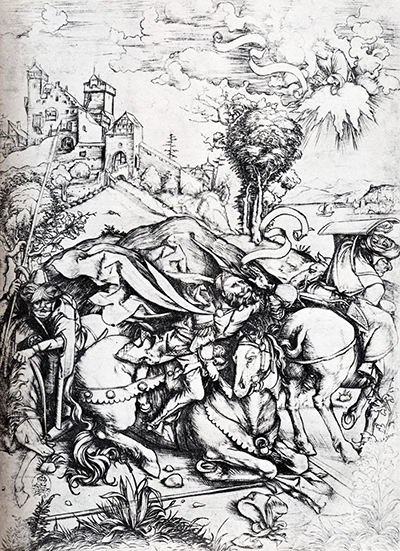The Conversion of Paul, created in 1495 is another religious work by the great artist and Renaissance man of Germany we know as Albrecht Dürer. The image is an engraving with amazing detail. It says much about the time of the artist as well as the art of his time.
It's also a superlative achievement, in conveying the story behind conversion of St. Paul. Readers of the New Testament will be familiar with the story of how Paul rode out from Jerusalem to Damascus, with the intention of arresting Jews practising the infant Christian faith and bringing them back to Jerusalem to give an account of themselves and possibly face terrible consequences. On this engraving, we see the contemporary German countryside of Albrecht Dürer's time. The figure of Paul is subdued and humbled on his horse, which has fallen to the ground, as are his attendants. There are also supernatural aspects to the painting.
Beyond the sky, Christ views the scene of the subdued Paul from Heaven. The figure of Christ in Heaven is illuminated, giving it supernatural quality. Paul, the man with great religious authority is humbled before the awesome power of the Man who walked the earth as Jesus Christ. The achievement of conveying this story through an engraving is astonishing. Albrecht Dürer excelled in woodcuts and engravings. Albrecht Dürer, was born in Nuremberg in 1471. He was very much a man of his time. Nuremberg was a centre of commerce and learning. It had a lively cultural and artistic atmosphere and the young artist was immersed in it. He was devoted to his art and began as a goldsmith, following the family trade.
Then he moved to the art of painting. But once he found his art, he became a pioneer, exploring and powering new techniques to express his artistic creativity. He reanimated the Biblical stories in visual terms. It must have been wonderful for those yet unable to read and write to behold the Biblical truths apparent in this artist's religious works. Albrecht Dürer died in 1528 at a relatively young age. He had not yet reached the age of 60. Yet he lives on eternally through his prolific body of work. A body of work which has been admired and cherished by subsequent generations. As an artist, his work had a profound effect, not only on the artists and audiences of his own generation but of subsequent generations also.




